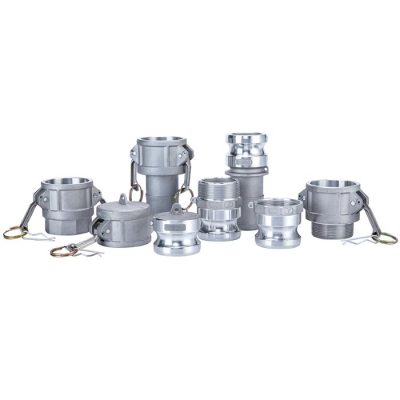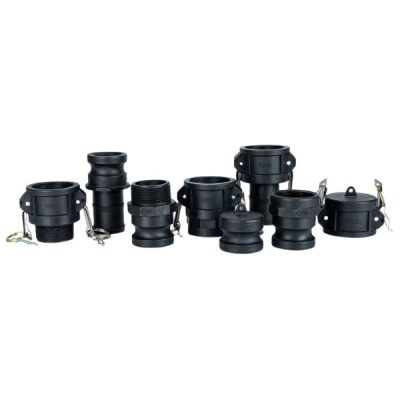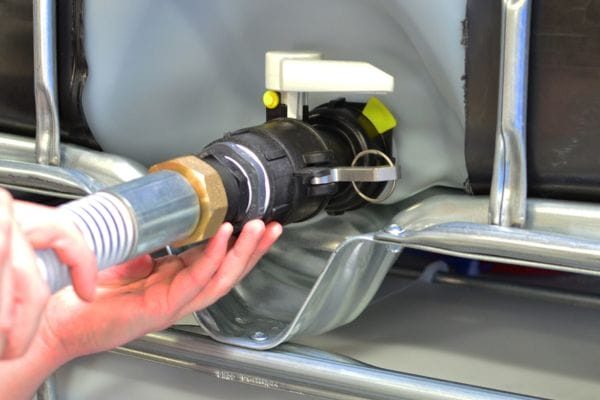Camlock fittings, also known as cam and groove couplings, are essential components in various fluid handling systems. These fittings are designed for quick and secure connections and disconnections of hoses and pipes, making them invaluable in industries that require efficient fluid transfer. The purpose of this article is to provide a comprehensive guide on the different types of camlock fittings available in the market. By understanding the various types, materials, and applications, readers can make informed decisions when selecting the right camlock fittings for their specific needs.
Camlock fittings, also known as cam and groove couplings, are a type of hose coupling used to connect and disconnect hoses quickly and without the need for tools. They are comprised of two parts: the coupler (female end) and the adapter (male end). The coupler has cam arms that lock into the adapter’s grooves when closed, creating a tight seal. This mechanism allows for easy connection and disconnection, making camlock fittings ideal for applications where hoses need to be frequently swapped or moved.
Camlock fittings have been around since the early 20th century and were initially developed to meet the need for quick and reliable hose connections in the military. Their design has evolved over the years, incorporating improvements in materials and manufacturing techniques to enhance their performance and reliability. Today, camlock fittings are standardized and used globally across various industries due to their proven effectiveness and efficiency.
Quick and Easy Connection/Disconnection
One of the primary advantages of camlock fittings is their ability to provide a fast and easy way to connect and disconnect hoses. The cam arms can be engaged or disengaged in a matter of seconds, without the need for any tools. This feature significantly reduces downtime and improves operational efficiency, especially in industries where hoses need to be frequently connected and disconnected.
Durability and Reliability
Camlock fittings are known for their durability and reliability. They are typically made from robust materials such as aluminum, stainless steel, brass, polypropylene, and nylon, each offering specific advantages depending on the application. For instance, stainless steel camlock fittings offer excellent resistance to corrosion and high temperatures, making them ideal for harsh environments. This durability ensures a long service life, reducing the need for frequent replacements and maintenance.

Type A camlock fittings have a male adapter and a female NPT (National Pipe Thread) end. They are typically used to connect hoses to a female NPT threaded connection. These fittings are designed for secure and leak-free connections in various industrial applications.
Type B camlock fittings feature a female coupler and a male NPT threaded end. They are used to connect hoses to a male NPT threaded connection, providing a secure and reliable link. Type B fittings are suitable for use in environments where quick hose disconnection is needed.
Type C camlock fittings consist of a female coupler and a hose barb end. These fittings are used to connect hoses to pipes or other hoses, providing a versatile and quick connection solution. They are commonly used in agricultural, industrial, and commercial applications.
Type D camlock fittings have a female coupler and a female NPT threaded end. They are designed to connect hoses to male NPT threaded connections, ensuring a secure and efficient link. Type D fittings are widely used in various fluid handling systems.
Type E camlock fittings feature a male adapter and a hose barb end. These fittings are used to connect hoses to pipes or other hoses, offering a quick and easy connection solution. They are suitable for a range of applications, including industrial and agricultural settings.
Type F camlock fittings consist of a male adapter and a male NPT threaded end. They are used to connect hoses to female NPT threaded connections, providing a secure and reliable link. Type F fittings are ideal for use in environments where quick hose disconnection is necessary.
Type DC camlock fittings are dust caps designed to cover and protect the female coupler end of a camlock fitting. They prevent dust, dirt, and debris from entering the system when the hose is not connected. Dust caps are essential for maintaining the integrity and cleanliness of the fluid handling system.
Type DP camlock fittings are dust plugs designed to cover and protect the male adapter end of a camlock fitting. Like dust caps, they prevent contaminants from entering the system when the hose is not connected. Dust plugs are crucial for ensuring the system remains clean and functional.
Lightweight: Aluminum camlock fittings are significantly lighter compared to other metal fittings, making them easier to handle and install.
Corrosion Resistance: Aluminum offers good resistance to corrosion, especially in less aggressive environments, ensuring a longer service life.
Cost-Effective: Generally, aluminum fittings are more affordable than those made from stainless steel or brass, providing a cost-effective solution for many applications.
Thermal Conductivity: Aluminum has good thermal conductivity, which can be beneficial in certain temperature-sensitive applications.
High Corrosion Resistance: Stainless steel camlock fittings offer excellent resistance to corrosion, making them ideal for harsh and aggressive environments.
Durability: Known for their strength and longevity, these fittings can withstand high pressures and temperatures.
Sanitary: Stainless steel is easy to clean and sterilize, making it suitable for hygienic applications.
Good Corrosion Resistance: Brass fittings offer excellent resistance to corrosion, especially from water and other liquids.
Malleability: Brass is relatively easy to shape and machine, allowing for precise manufacturing.
Conductivity: Brass has good electrical conductivity, which can be beneficial in specific applications.
Aesthetic Appeal: Brass has a distinctive appearance, making it suitable for decorative and visible applications.

Chemical Resistance: Polypropylene camlock fittings are highly resistant to a wide range of chemicals, making them suitable for many industrial applications.
Lightweight: These fittings are lighter than metal fittings, which can simplify installation and handling.
Non-Conductive: Polypropylene is an electrical insulator, making these fittings suitable for certain electrical applications.
Chemical Processing Plants: In chemical processing plants, camlock fittings are used to transfer various chemicals safely and efficiently. For example, in a plant producing industrial cleaners, camlock fittings enable quick connection and disconnection of hoses carrying corrosive materials, minimizing exposure and reducing downtime.
Manufacturing Facilities: Camlock fittings are utilized in manufacturing processes to transfer oils, lubricants, and coolants. A case study from an automotive manufacturing plant showed how the use of stainless steel camlock fittings improved the efficiency of their coolant systems, reducing spillage and maintenance time.
Construction Sites: At construction sites, camlock fittings are used in dewatering operations and for transferring concrete admixtures. In one case, a large construction company used aluminum camlock fittings to streamline their water removal process, significantly speeding up the project timeline.
Irrigation Systems: Camlock fittings are essential in agricultural irrigation systems, allowing for quick changes and repairs. For instance, a large-scale farm improved its irrigation efficiency by replacing traditional threaded fittings with polypropylene camlock fittings, which reduced water loss and maintenance costs.
Fertilizer Distribution: In the distribution of liquid fertilizers, camlock fittings provide a secure and leak-proof connection. A case study from a commercial farm demonstrated how using brass camlock fittings in their fertilizer application systems enhanced the uniformity and accuracy of fertilizer delivery.
Livestock Watering Systems: Farms often use camlock fittings in watering systems for livestock. An example from a dairy farm showed that stainless steel camlock fittings helped maintain a clean and efficient water supply system, crucial for the health and productivity of the animals.
Fuel Transfer: In the petrochemical industry, camlock fittings are used to transfer fuels like gasoline, diesel, and jet fuel. A refinery case study highlighted how the implementation of stainless steel camlock fittings improved the safety and speed of fuel transfers, reducing the risk of spills and fire hazards.
Oil Exploration and Drilling: Camlock fittings are used in oil exploration and drilling operations to handle drilling fluids and other chemicals. A drilling company reported that using aluminum camlock fittings in their fluid handling systems increased operational efficiency and reduced equipment wear.
Chemical Transportation: For transporting chemicals, camlock fittings ensure a secure connection between containers and transfer lines. A logistics company specializing in chemical transport found that polypropylene camlock fittings reduced the risk of leaks during transit, ensuring safe and compliant operations.
Selecting the right camlock fittings for your application is crucial to ensure optimal performance, safety, and longevity. Here are the key criteria to consider when choosing camlock fittings:
Fluid Type: The type of fluid being transferred (e.g., water, chemicals, fuel) significantly impacts the choice of camlock fitting material. Certain materials are better suited to handle specific fluids to avoid corrosion and contamination.
Pressure Ratings: Ensure the camlock fitting can withstand the operational pressure of your system. Different materials and types have varying pressure ratings, so it is essential to match the fitting to your system’s requirements.
Temperature Range: Consider the temperature of the fluid and the operating environment. Materials like stainless steel can handle higher temperatures, while polypropylene is better suited for lower temperatures.

Chemical Compatibility: Use materials like polypropylene or stainless steel for transferring aggressive chemicals to prevent corrosion and ensure longevity.
High-Pressure Applications: For high-pressure systems, stainless steel or aluminum fittings are ideal due to their strength and durability.
Food-Grade Applications: In the food and beverage industry, use stainless steel or food-grade polypropylene fittings to meet sanitary standards and avoid contamination.
Connection Standards: Check that the camlock fitting complies with the relevant connection standards (e.g., NPT, BSP) used in your system. This ensures a secure and leak-free connection.
Hose and Pipe Sizes: Ensure the camlock fitting is compatible with the hose or pipe sizes in your system. Proper sizing is crucial to prevent leaks and ensure efficient fluid transfer.
System Integration: Consider how the camlock fitting will integrate with other components in your system, such as valves, pumps, and filters. Compatibility with existing equipment is essential for seamless operation.
Corrosion Resistance: Choose materials like stainless steel or brass for applications involving corrosive fluids or harsh environments to ensure the fittings last longer.
Wear Resistance: For applications involving abrasive materials or frequent connections and disconnections, select fittings made from robust materials that can withstand wear and tear.
Environmental Factors: Consider the environmental conditions where the fittings will be used. For instance, marine applications require fittings with high resistance to saltwater corrosion, such as stainless steel.
General Installation Steps for All Camlock Fittings:
Inspect the Fittings: Before installation, check both the coupler and adapter for any signs of damage, wear, or debris. Ensure that the cam arms and grooves are clean and free from obstructions.
Prepare the Hose and Fittings: Cut the hose to the desired length and ensure the cut is clean and straight. Slide the hose clamp over the end of the hose before inserting the fitting.
Insert the Adapter: Push the adapter (male end) into the hose until it is fully seated. Secure the hose with a hose clamp, ensuring it is tight enough to prevent leaks but not so tight as to damage the hose.
Connect the Coupler: Align the coupler (female end) with the adapter. Open the cam arms fully, then insert the adapter into the coupler.
Engage the Cam Arms: Close the cam arms simultaneously until they are fully locked in place. Ensure that the cam arms are flush with the coupler body and that the connection is secure.
Test the Connection: Once connected, test the fitting by running a small amount of fluid through the system to check for leaks. Tighten the hose clamp or adjust the cam arms if necessary.
Over-tightening Hose Clamps: Over-tightening can damage the hose and lead to leaks. Ensure clamps are snug but not overly tight.
Forgetting to Inspect Fittings: Always inspect fittings for damage or debris before installation to prevent leaks and ensure a secure connection.
Improper Alignment: Ensure that the adapter and coupler are properly aligned before closing the cam arms to avoid damage to the fittings.
Neglecting to Test the Connection: Always test the connection with a small amount of fluid to check for leaks before putting the system into full operation.
In summary, selecting the right camlock fittings is crucial for ensuring efficient and reliable fluid handling in various industries. By understanding the different types, materials, and applications, you can choose fittings that offer durability, versatility, and ease of use. We encourage you to make informed decisions when selecting camlock fittings and invite you to reach out for further questions or professional consultation to ensure you choose the best solution for your specific needs.
Camlock fittings, also known as cam and groove couplings, are connectors used to quickly and securely join hoses and pipes without the need for tools. They consist of a male adapter and a female coupler with cam arms that lock into place.
Camlock fittings are commonly made from aluminum, stainless steel, brass, polypropylene, and nylon. Each material offers specific advantages depending on the application, such as corrosion resistance, durability, and cost-effectiveness.
When choosing a camlock fitting, consider factors such as the type of fluid being transferred, pressure and temperature requirements, compatibility with existing systems, and the material’s durability and cost.
To install camlock fittings, ensure the hose and fittings are clean and free from damage. Insert the adapter into the hose, secure with a clamp, align the coupler, and engage the cam arms until locked. Test the connection for leaks before full operation.
Regularly clean camlock fittings with mild detergent and water, inspect for wear and damage, and apply light lubricant to the cam arms and grooves. Replace any worn or damaged components to ensure optimal performance.
Camlock fittings are widely used in industrial manufacturing, agriculture, petrochemical, food and beverage processing, and construction. They are valued for their quick connection capabilities, versatility, and reliability in handling various fluids.